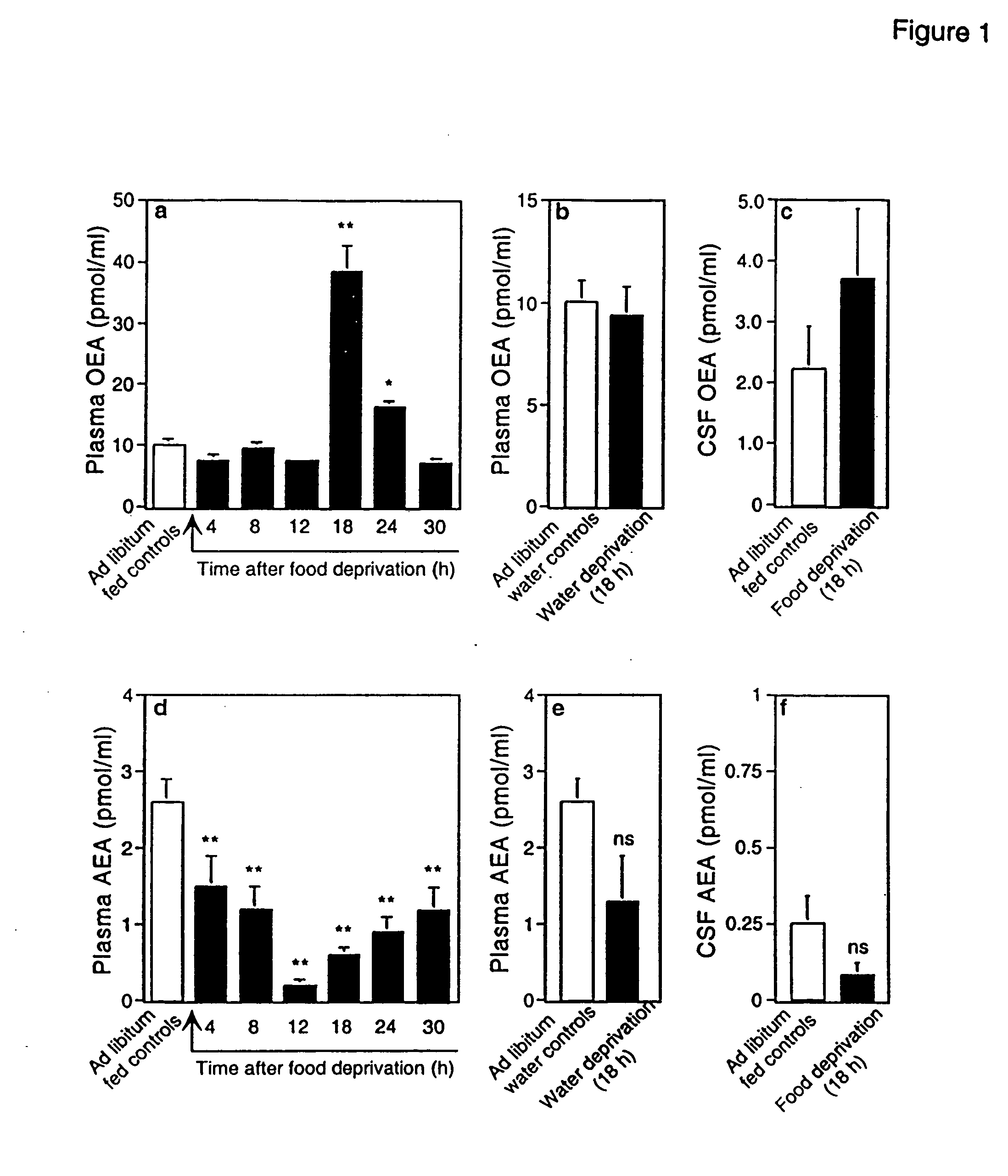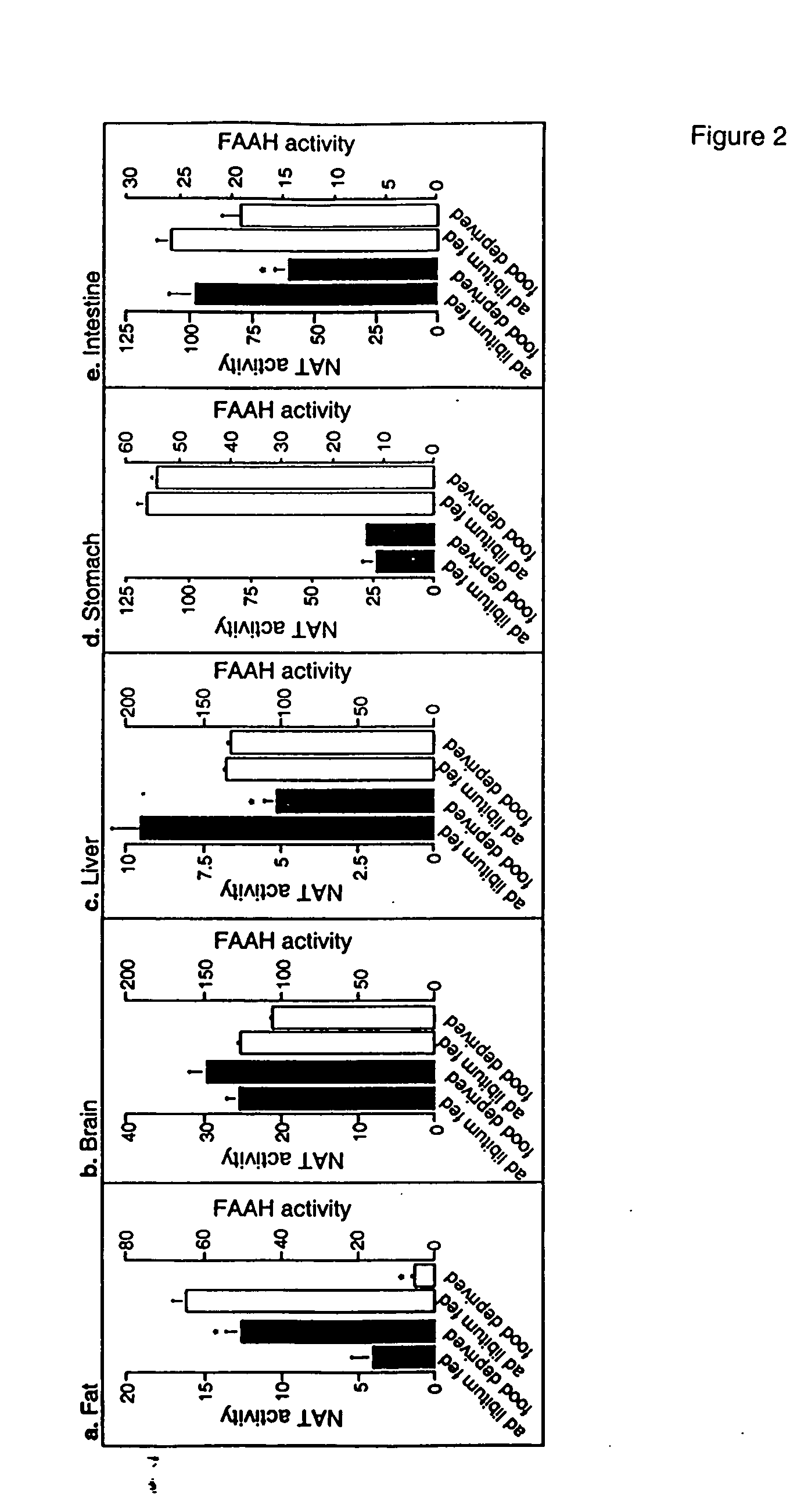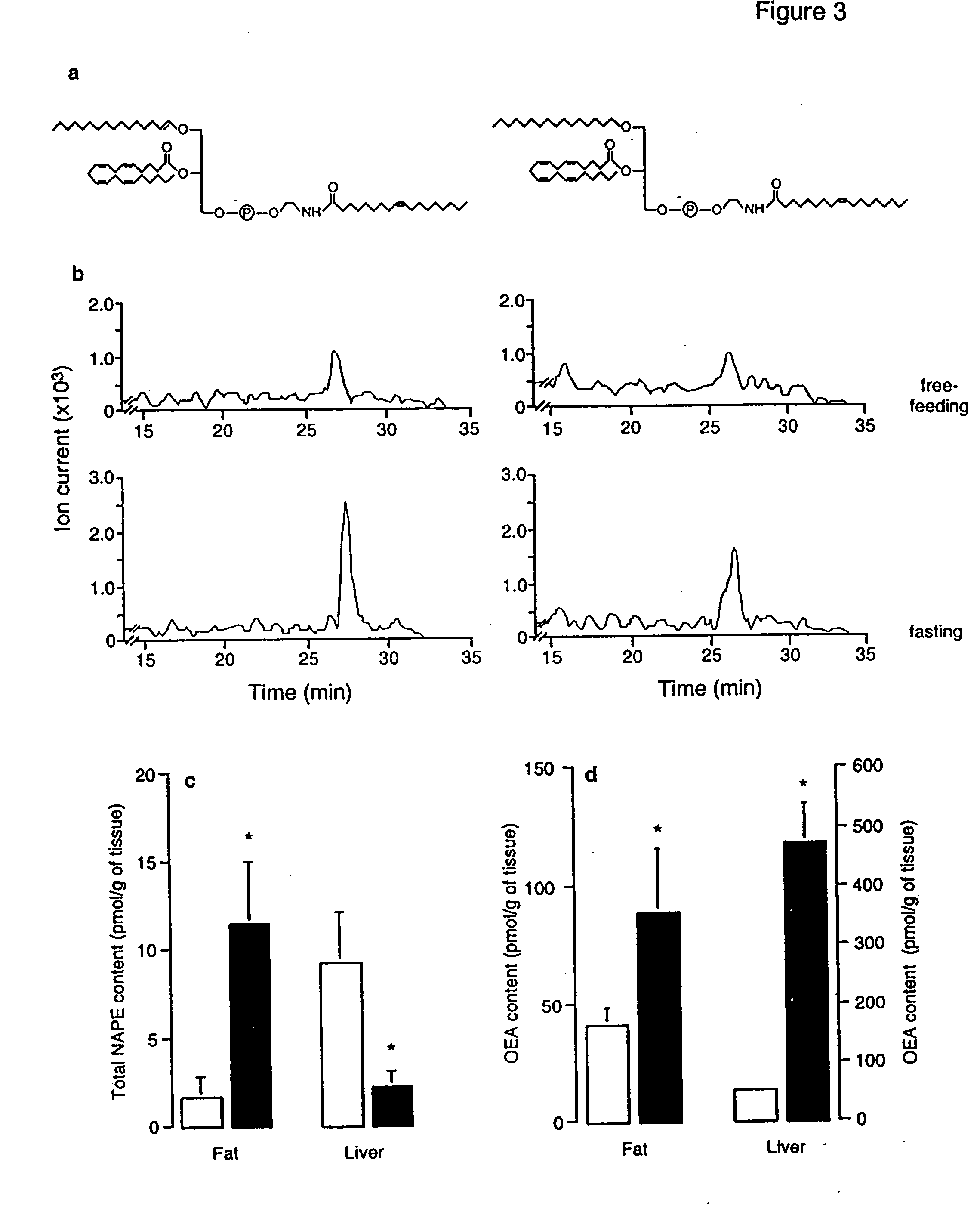Combination therapy for controlling appetites
a combination therapy and appetite control technology, applied in the field of cannabinoid receptor antagonists, can solve the problems of increasing the risk of many diseases, difficult to achieve, and high all-cause death rate of persons with higher body weight, so as to reduce appetite, reduce appetite, or control appetite
- Summary
- Abstract
- Description
- Claims
- Application Information
AI Technical Summary
Benefits of technology
Problems solved by technology
Method used
Image
Examples
example 1
Synthesis of Fatty Acid Ethanolamide Compounds, Homologues and Analogs
[0334] Methods for the formation of fatty acid ethanolamines from ethanolamines and the corresponding fatty acyl are relatively straight forward and known to one of ordinary skill in the art. For example, fatty acid ethanolamides may be synthesized by reacting a fatty acid or fatty acid chloride with an aminoalcohol as described by Abadji et al. (Abadji, V., Lin, S. Y., Taha, G., Griffin, G., Stevenson, L. A., Pertwee, R. G. & Makriyannis, A. J. Med. Chem. 37, 1889-1893 (1994)). Fatty acids may be prepared similarly to the procedure of Serdarevich and Carroll (Serdarevich, B. & Carroll, K. K. J. Lipid Res. 7, 277-284 (1966)). Radioactively labeled fatty acid ethanolamides can be prepared by reaction with acyl chlorides (Nu-Check Prep, Elysian, Minn.) with [3H]ethanolamine (10-30 Ci / mmol; American Radiolabeled Chemicals, St. Louis) as described by Desarnaud, F., Cadas, H. & Piomelli, D. (1995) J. Biol. Chem. 270, ...
example 2
Test Methods, Physiology and Pharmacological Activity of OEA-Like Compounds and / or OEA-Like Modulators
[0338] Animals. Male Wistar rats (200-350 g) were used. Procedures should meet NIH guidelines detailed in the Guide for the Care and Use of Laboratory Animals, and the European Communities directive 86 / 609 / EEC regulating animal research.
[0339] Chemicals. FAEs and [2H4] FAEs were synthesized in the laboratory (Giuffrida, et al., “Lipid Second Messengers” (ed. Laychock, S. G. & Rubin, R. P.) 113-133 (CRC Press LLC, Boca Raton, Fla., 1998)); 1,2-dioleyl-sn-glycero-phosphoethanolamine-N-oleyl was purchased from Avanti Polar Lipids (Alabaster, Ala.); SR141716A was provided by RBI (Natick, Mass.) as part of the Chemical Synthesis Program of the NIMH (N01MH30003); SR144528 was a generous gift of Sanofi Recherche; all other drugs were from Tocris (Ballwin, Mo.) Or Sigma (Saint Louis, Mo.). FAE were dissolved in dimethylsulphoxide (DMSO) and administered in 70% DMSO in sterile saline (acut...
example 3
PPAR Modulation by OEA-Like Compounds and OEA-Like Modulators: Methods, Physiology and Pharmacology
Chemicals
[0375] GW 7647 {2-(4-{2-[3-Cyclohexyl-1-(4-cyclohexyl-butyl)-ureido]-ethyl}-phenylsulfanyl)-2-methyl-propionic acid was synthesized as follows. Phenethylamine was reacted with 4-cyclohexyl-butyric acid in the presence of diisopropylcarbodiimide and hydroxybenzotriazole (HOBT) in CH2Cl2. The resulting amide was treated with chlorosulfonic acid and PCl5 to obtain 4-[2-(4-Cyclohexyl-butyrylamino)-ethyl]-benzenesulfonyl chloride, which was reduced (zinc dust / NaOAc / Ac2O / glacial AcOH), to give thioacetic acid S-{4-[2-(4-cyclohexyl-butyrylamino)-ethyl]-phenyl}ester, the reaction of which with 2-bromo-2-methyl-propionic acid tert-butyl ester under strong basic condition afforded 2-{4-[2-(4-cyclohexyl-butyrylamino)-ethyl]-phenylsulfanyl}-2-methyl-propionic acid tert-butyl ester. This intermediate was then used in the synthetic route reported by Brown et al (Brown et al., 2000), lead...
PUM
| Property | Measurement | Unit |
|---|---|---|
| enantiomeric excess | aaaaa | aaaaa |
| enantiomeric excess | aaaaa | aaaaa |
| enantiomeric excess | aaaaa | aaaaa |
Abstract
Description
Claims
Application Information
 Login to View More
Login to View More - R&D
- Intellectual Property
- Life Sciences
- Materials
- Tech Scout
- Unparalleled Data Quality
- Higher Quality Content
- 60% Fewer Hallucinations
Browse by: Latest US Patents, China's latest patents, Technical Efficacy Thesaurus, Application Domain, Technology Topic, Popular Technical Reports.
© 2025 PatSnap. All rights reserved.Legal|Privacy policy|Modern Slavery Act Transparency Statement|Sitemap|About US| Contact US: help@patsnap.com



